

a MARIO GIACOMELLI
14
Omaggio
ASTA DI SENIGALLIA
MAGGIO 2022
ASTA DI FOTOGRAFIA SENIGALLIA, ROTONDA AL MARE
14 maggio 2022 ore 18.00

© All the works of Giacomelli are protected by copyrights, belonging to the Giacomelli archives, in Senigallia and Sassoferrato. We have reproduced the prints, books and works o ered in the sale, presented as objects, with all possible details on their intrinsic defects, respecting the Italian and European laws on free exchange.
NOTE: e profits of the sale will be dedicated to the projects of the next Biennale of Senigallia, to the financing of the works of young contemporary artists and professionals of the crafts, and in particular to the reception in the city of the Adriatic coast of two young artists victims of the current war.

Mostra dei lotti

10-24 marzo 10:00-19:00
PARIS, Hôtel Parister, 19 rue Saulnier 01 aprile-10 maggio 16:00-18:00
SENIGALLIA, Atelier 41, via fratelli Bandiera
maggio 10:00-19:00
, Rotonda al mare
giorno dell’asta
10:00-17:00
11-13
SENIGALLIA
e il
14 maggio
Omaggio a MARIO GIACOMELLI ASTA DI FOTOGRAFIA SENIGALLIA, ROTONDA AL MARE 14 maggio 2022 ore 18.00 lot n°13, detail
Indice, Summary
Le stampe di un tipografo, e Art and Pleasure of Printing
Enzo Carli, e Poetic Reality of Giacomelli
La terra che cambia, an early cropping, 1956 1
Stampe smaltate, ferrotyped prints, 1968-1969 2-6
Grandi formati, large & extra-large prints, 1971-1973 7-18
“Provini”, small cuts, croppings, annotated proof prints 21-35
Formati “30x40”, 16-17, 19-20, 36-41
Foto a colori, color photographs 42-45
Quadri, Giacomelli as a painter, four canvases 47-50

Dante Panni, Ivo Pompili, Enzo Marinelli 51-57
Supplemento, l’artista nella vita quotidiana di Senigallia 59 ...
Africa, Perché ? 1974 60-63
Ladakh, viaggio fotografico di Enea Discepoli 64-67
Cataloghi, locandine, menù, ritratti 68-82
Senigallia, città della fotografia, May 2022 Exhibitions
Marion Pardo, Céline Esposito and Margaux Carrez, students in Master of curatorial studies at the Polytechnic University of Hauts-de-France, participate in the preparation of the exhibition and the conception of the catalog as part of their ERASMUS internship.
Le stampe di un tipografo, e Art and Pleasure of Printing
When visitors enter the exhibition, they are surprised by the strong physical presence of the works of the artist from Senigallia, by the contrasts, by the grain of the papers, by the material in general, both in the prints and the paintings.
If we were to try to establish categories among the prints, in addition to the dimensions and dates, we have an interesting approach to go through the variety of Mario Giacomelli's prints, his presence, his proximity, his intervention in the elaboration of each object.
In the European market of collectible photography, we respect the legal and fiscal definition of collectible photography: the original work of a photographer is a print made under his direction or instructions, numbered to less than 30 copies and signed.
Mario Giacomelli has created and produced for fifty years of his life works without worrying about the recent accounting and customs definitions, but his intervention is very present and his instructions are taking shape, we can read them as he has traced them himself in ink on the trial prints.
e photographs entrusted by the inhabitants of the city have been grouped into five groups.
— Desired works, accomplished and at the same time experimental, daring reframing, contrast, glazing, very large formats reserved for his personal exhibitions in the city of Senigallia (n°2-19). e most desirable lots.
— Signed prints of works that became famous, 30x40 cm, proofs printed for exhibitions in Italy or farther away, for friends or for collectors (comparison with Haute-couture which becomes Prêt-à porter)
— Editions for galleries of well known works, homogeneous quality prints, signed
— Test prints, "provini", annotated contact prints
— Prints from the back of the studio, experiments, tests of contastes not retained, bold cuts, prints authenticated by one heir but attacked by the other for the great confusion of collectors.
In the catalog we have considered the chronology of the positives rather than the negatives. e two approaches give very di erent results. e chronology of the negatives goes in the direction of the public's expectations, it is an agreed way to understand the evolution of an artist, the accounting logic of the agencies also.
But if we consider the experience of the photographer, of the artist who decides what is important in his work, without respecting the accounting chronology but rather that of the interests he has in a particular image, its format, the emotion it arouses for him at a particular moment in his life ... it is more his choice of personal human life than the numbering of the negatives, it is his emotional or temporal selection, what he retains important of his work at such or such an exhibition.
Posthumous prints have no proximity to a living artist as their name indicates. ey have value for the right owners but are not part of our study. at's something else, it goes without saying.
One will observe the variety of stamps - address stamps, poem stamps, series title stamps - signatures - in ink, in pencil, in faded ink - dates - print date, matting date, exhibition date, signature date. In the catalog we have adopted the following convention: the main date is that of the print, that of the artist's intention, it is in bold, followed, when it is di erent, by the date of the shooting, in brackets.
A visitor came on the last day of the exhibition at the Parister Hotel, March 24, 2022. He was surprised by the dimensions, by the signatures, the contrasts, the material presence of the works in general. He was adamant - "I have known Giacomelli's work since the 1970s. I was editor of a magazine. I have never seen these formats, these signatures. I tell you: I do not believe in them, they are fake".
e incredulity of this visitor becomes a singular homage to the production of this artist who has not finished surprising by the diversity of the works born of a curiosity without limit associated with an opening of spirit and conscience to 360°.
And makes him the most wonderful ambassador of the almost ancient times to the first generations of students of the Digital Era.
Margaux Carrez, Céline Esposito, Marion Pardo, student curators, University of Valenciennes, Erasmus internship directed by Serge Plantureux, Senigallia, 2022


Lot 7 (detail)
lot n°2, detail
Enzo Carli, e Poetic Reality of Giacomelli, translated from Italian
Mario Giacomelli, unanimously considered by critics and the public as one of the greatest photographers of our time, and who left us after a long illness on November 25, 2000, traveled through the infinite landscapes of the soul with his work.

Born in Senigallia on August 1, 1925, his activity as a photographer began on Christmas Eve 1952 when he bought a Comet camera and went to the beach to photograph the sea. In order to reproduce the movement and animation of the sea, he moved the camera: his first photograph, L'approdo [ e approach, the boarding] was born; with it, he consciously moved away from the photographic tradition.
His participation in the Senigallia group of photographers "Misa", founded by Giuseppe Cavalli (with Paolo Monti among the theorists of the "new Italian photography") allows Giacomelli to leave the framework of his small provincial town to integrate into a wider cultural universe, closer to his motivations and aspirations. However, the most important works of the great master are indissolubly linked to his land: "While I feel like a realist [Giacomelli told me], I have discovered that poetry is the language with which I believe I can escape the clichés of everyday reality. e space is no longer trivialized; the things that I always saw similar, the same streets, the same people in my city, thinking about their poetry, now seem to me modified. Everything has a taste of adventure that leads me into new experiences and makes me live in imaginary territories.
"In 1955 he won the first prize for the best series at the second National Photography Exhibition in Castelfranco Veneto. Paolo Monti, who presided over the jury, said that Giacomelli was the new man in Italian photography. In 1957 he was published in the prestigious Photography Year Book (London) and in 1958 in U. S. Camera (New York). In 1959, in the magazine Fotografia, the late critic Giuseppe Turroni spoke of Giacomelli's first and second ways and, on the occasion of the exhibition at the Biblioteca Comunale in Milan in 1959, he wrote of the photographer from Senigallia that he was the "case" of Italian photography. In 1963, thanks to John Szarkowsky, then curator of the Department of Photography at the Museum of Modern Art (MoMA) in New York, Giacomelli arrived on the international scene with the Scanno series (1957), first with an appearance in Looking at Photographs, then with a permanent exhibition in the collections of the Museum of Modern Art.
After a series of early titled photographs between 1953 and 1956, probably influenced by his friend Luigi Crocenzi - one of the founders in 1954 of the Centro per la Cultura della Fotografia (CCF) in Fermo and one of the theorists and promoters of the photographic narrative - Giacomelli tackled the major themes, keeping the titles for the photographic series.
e series (made with a Bessamatic and an Eliar 10.5 color lens with lamp flash) on Life in the Hospice dates from 1954-1956. Mario Giacomelli knew the life of the hospice since, as a child, he followed his mother who worked there out of necessity after her widowhood. rough his encounters with the old people of the hospice in Senigallia, the story of an infinite love was woven. is is why he returned there in 1966-1968 for a series of works whose title is taken from a poem by Pavese, Verrà la morte e avrà i tuoi occhi [Death will come and have your eyes]. He brings his images to the edge of abstraction: the flesh is "burned" by the flashlight and the wrinkles of the faces are those of the earth. ese blurred images are imbued with a deep lyricism that recalls Licini. He returned to the hospice in Senigallia for another untitled series in 1981-1983.
For nine years, then, Giacomelli photographed the elderly, without ever making a reportage, without ever having the requirement or intention of denouncing or expressing social contempt. At a time when photography is by definition the mirror of reality, the hospice is for Mario a place of encounter and fascination to understand his fears, to exorcise death.
Above all, to understand time, made of "a bit of before and a bit of after", Giacomelli will say: — "It is not easy to photograph the life of the hospice... is mother who has been waiting for her son for three years and who takes my hand when I bring her sweets to see her happy for a moment, and who says that her son is so busy that he cannot come to see her. [...] I go to hospice out of an inner need.”
“— In several images, I have removed the material with the white; by removing the details, I destroy the reality. e deformations, the blurs destroy the overflow of reality to regenerate poetry. I did not make beautiful images, I only hid in a place that others call a hospice and that, for me, was a large mirror that allowed me to look at myself. [...] I felt then that my fears were not inventions but things that I was already living and of which I was a prisoner. "
From 1955 until his death, he worked on the landscape of his native land - a work still in progress - which represents a fundamental chapter of his work as an artist and an excellent key to reading his intimate convictions. "I do not represent landscapes, but the signs and memory of existence. " ese are cuts, like the lines that man has in his hands, like the wrinkles of the old men in the hospice, like the tears of nature and humanity, dug by the traumatic passage of time. Between 1961 and 1963 he made the series Io non ho mani che mi accarezzino il volto [ ere are no hands to caress my face]. In this fantastic series of "Pretini" [Priests], photos taken at the Episcopal seminary of Senigallia, Giacomelli reaches the peak of abstraction through the iconic transgression of suspended images and cassocks inflated like small balloons.
Between 1964 and 1966, he proposed the series entitled La buona terra [ e Good Earth], an epic saga, punctuated by the passage of cycles, seasons and characterized by the ancient peasant ritual. e images develop in the course of this reportage/narrative, with the participation of Giacomelli who, after a time of adaptation (he photographs the life of a patriarchal family in the vicinity of Senigallia), befriends the protagonists, following them in their work in the fields and in their moments of celebration. Once again, this is not a realistic documentary with political and social intentions, but a rereading of time, memory and peasant memory.
e Caroline Branson series, based on Edgar Lee Master's Spoon River Anthology, dates from 1971-1973. It is a love story rich in meaning, supported by striking signs and naturalistic elements - as if to underline the dramatic aspect of the story -, an alternation of evocative images, with a strong emotional impact accentuated by the double exposure. Here too, under the pretext of the story of Senigallia, here is the intensity of the cosmic night, of the darkness of memories, of the absence / presence of space-time.
Giacomelli's photography is therefore the metamorphosis of his intimate convictions: a magical realism, filtered by memory and filled with poetry. His images — selfanalysis and mirror of existence — draw their inspiration from his travels to his inner spaces and imaginary territories.
He transposes into photography his passion for his native land, for the cycles and periods of existence. Inscribed in filigree in his memory, these almost invisible relationships with his mental universe allow him to bring to life, in the folds of the material and in an imaginary reality, the joy of creation and knowledge.
Giacomelli approaches with the photography serious and worrying themes, and he loads them with poetry, puts them back in their original dignity, without ideological dogma nor academic turn. He is far from the pretentiousness that is widespread among contemporary artists; he knows that every research must find the authenticity of life, know the links between the forms of expression and rehabilitate our origins.
He feels sorry for the powerlessness of man in the face of deformity and evil; his photographic writing expresses these feelings. With his images accentuated by the luminous contrasts, by the blurs, by the amplification of the grain, he wants to exceed the anguish of the pain and the loneliness and to transmit us a message of hope. "What interests me is the joy I felt at the moment I triggered the camera, the tension I had in front of the image.”
“— at's it, from that moment on [Giacomelli states], the image no longer dies, it remains after my death... I would like to escape this reality and enter the useless one of poetry. "

"Avanti! Si accendano i lumi / nelle sale della mia reggia! / Signori! Ha principio la vendita / delle mie idee. " [Come in! Let the lights be turned on / in the rooms of my palace! / Gentlemen! e sale of my ideas begins]. us begins the poetry of Corazzini Bando [Notice of Sale], from which Giacomelli was inspired for one of his last works that borrows its title. us he decided to conclude his own "research" by getting rid of his artistic and intellectual baggage; turning the very concept of poetry upside down, refuting the idea of purity and intimacy as an end in itself, with which it has always been satisfied. He shows us, instead, how he conceived his research with more distance: exactly as in an auction, when the personal ideas become those of the buyer; it seems clear then that the interpretations that we want to attribute to them are only ours. At the root of this reasoning is the realization that life is changeable: not material things, but the very nature of ideas that distort, assemble and amplify, continually losing and gaining meaning.
It is in fact in his last work, Interrogando l'anima [Questioning the soul], that Giacomelli reconsiders his path inside and outside of poetry, providing us with other keys to read his work.
He has done nothing more than group his previous works (mixing them with others), providing each group of series with a new title, and therefore new points of reflection, sometimes totally di erent from the previous foundations.
Let's take an example: the images of the "Pretini", which at the time of their publication were titled with the beautiful line of a poem by Father David Turold, Io non ho mani che mi accarezzino il volto [ ere are no hands to caress my face], take on a completely di erent meaning in this latest collection - which is nothing more than a summary of his larger work - with a title that has become, for the occasion, La spensieratezza [ e carefree].
e di erences between the two titles shed new light on the same photographic narrative: initially, the title taken from the poetry conveyed a certain melancholy because it evoked for us - in the context of these images where priests play together, amused and carefree - the wearing of the cassock and, from then on, the total solitude of the body deprived of all physical contact. e new title is no longer a reference to their existential solitude, but a simple reminder of the emotion (that of insouciance, therefore) that invades them at these moments, and that the images invariably comment on.
Lot 15
In this game of mirror that is his work, Giacomelli in turn plays with the costume of the artist and becomes his own "salesman", who proclaims with a loud voice that "the sale of his ideas begins". In fact, if we return to Bando, we can observe that his imagination is filled with signs - signs of the passing of time and recycling, just like the attempts of the poet to free himself from his verses to create new ones, or like those of the salesman who wants to get rid of his obsolete merchandise to replace it.
is symbolism tries in its turn (play of mirrors) to free itself from the commonly accepted rhetoric that puts poetry above all else, because poetry does not represent life, but transfigures it and unfolds it in time. We think of the smashed windows, the stale armchairs, the rotten wood and the bare cement frames that make up some of the shots in the Bando themed series, that micro-universe of inner tracings, shots that, beyond their hermeticism, express the disintegration of matter under the action of time and appeal to the imagination.
We now think of the puppets, the mask, the crows (a reference to the dark poem e Raven, by Edgar Allan Poe), the dogs, the elongated shadows, the cups of the tree, the old men of the hospice, the journey to Lourdes, the sea and the land, all these vast and complex themes that make up the artist's final account and contribution to the world in the series Interrogando l'anima.
We understand then that the photographic image can become a story that speaks to us more or less directly about the inner journey of a man.
Mario Giacomelli participates with great tenacity and rigor in the elaboration of the Manifesto of the Photographers of the Center Studies Marches, later called Manifesto of the Photographers of the Passage of Border (Senigallia,1995 ). e Manifesto, coordinated by Enzo Carli, sees the participation of photographers of the most di erent waves, including Gianni Berengo Gardin, Ferruccio Ferroni, Giorgio Cutini, Luigi Erba beyond Mario Giacomelli...
I sincerely hope that Mario Giacomelli is now and forever in the "useless reality of poetry", that place that he never stopped looking for and from which he returned every time with images that served to tell it. For which we thank this great Master.
Enzo Carli, Senigallia, 2022
ASTA DI SENIGALLIA CATALOGO
Mario Giacomelli
La Terra che cambia, I, 1956
Vintage print on postcard paper stock, 88x140 mm, several intentional folds
300/400
Early photographic essay on a specific spot of his native landscape, the hills, with several folds indicating an intuitive cropping. He went back several times to observe changes and photograph from the same spot within time.


Lot 1
lot
Digital
reconstruction of the intented cropping of
n°1
Mario Giacomelli
Notte riva al mare, Senigallia, 1968 (1956)

Ferrotyped silver print, 168x390 mm, printed 1968 from a 1956 negative, signed and dated, ink, verso, signed and dated, ink, on original mount

4.000/5.000
Rare and unpublished, a group of five ghosty figures are present in the middle of the image. According to direct witnesses, this print was glazed in the artist’s home with Giuseppe Cavalli’s photo prints dryer.
Lot 2
Mario Giacomelli Paesaggio (smaltata), 1968

Ferrotyped silver print, 390x259 mm, signed, dated “1968”, ink, verso, signed, dated “1969”, ink, on original mount 5.000/6.000
Mario Giacomelli was precise with dates: “1968” corresponds to the date of printing and “1969” to the date of mounting by the artist. Arturo Carlo Quintavalle, Mario Giacomelli, Feltrinelli, 1980, page 215 (slightly di erent cropping).
Lot 3
Mario Giacomelli

Paesaggio, Landscape (smaltata), ca. 1968

Ferrotyped silver print, 221x334, ink signature on recto, and a second relief signature on recto with an alternative orientation, some surface defects
1.800/2.000
We can think the artist invites us to consider his landscape in both orientations. Printed and ferrotyped by Sandro Luchetti at the artist’s home, or in the darkroom of Fratelli Torcoletti, Senigallia.
Lot 4
Mario Giacomelli
Pineta di Ravenna, 1968 (1961)


Solarised silver print, 185x395mm, printed 1968 from a 1961 negative, signed and dated “1968” ink, verso, signed and dated “1969”, ink, on original mount 1.800/2.000
Mario Giacomelli dated his prints with the date of printing, verso, and with the date of mounting, on mount.
Nel mezzo del cammin di nostra vita mi ritrovai per una selva oscura ché la diritta via era smarrita
Dante, Inferno, Canto I
Il canto primo dell'Inferno di Dante Alighieri funge da proemio all'intero poema, e si svolge prima nella selva e poi sul pendio che conduce al colle; siamo nella notte tra il 24 e il 25 marzo 1300 (anniversario dell'Incarnazione di Gesù Cristo). Gli ultimi tre anni di vita trascorsero relativamente tranquilli nella città di Ravenna, durante i quali Dante creò un cenacolo letterario.
Lot 5
Mario Giacomelli
Pilgrims, Lourdes, ca. 1968 (1957)

Vintage ferrotyped silver print, 387x230 mm, from a 1957 Lourdes negative, annotation in Italian, pencil, verso : “this print was glazed in the artist’s home with Giuseppe Cavalli’s photo prints dryer”
1.000/1.200
Arturo Carlo Quintavalle, Mario Giacomelli, Feltrinelli, 1980, page 110. Enzo Carli, Il reale immaginario di Mario Giacomelli, il lavoro editoriale, 1988, page 66.
Lot 6
Mario Giacomelli
Io non ho mani che mi accarezzino, 1971 (1963)
Extra large silver print, 600x800 mm, printed 1971 on matte paper (Agfa-Brovira 3), signed, dated, numbered by the artist “1/10”, ink, recto, certificate-stamp, verso, small creases
9.000/10.000
One of the rarest and possibly most desirable Giacomelli prints to be found. Print numbered 1 of a projected edition of 10. Nobody knew this print and in Photopoche n°19, Michel Frizot wrote the young priests where playing in the snow for the greatest pleasure of the facetious Italian artist. In the late 1990, Giacomelli made a few small prints with the pavement visible for local friends.

Lot 7
Mario Giacomelli
Io non ho mani che mi accarezzino, 1972 (1963)
Large silver print, 505x600 mm, printed 1972, signed verso (?), signed and titled, pencil, on mount, original frame on artist’s instructions, blackened wood, 106x86 cm, “Corniceria Angelini” label
6.000/8.000
Without pavement details, the ground now looks just like snow. Enzo Carli, Il reale immaginario di Mario Giacomelli il lavoro editoriale, 1988, page 71. Alistair Crawford, Mario Giacomelli, Phaidon, 2001, page 225

Lot 8
Mario Giacomelli

Nudo di Donna, 1972 (1967)
Extra large vintage silver print, 801x602 mm, printed 1972, signed, dated, dedicated, ink, on recto, titled and signed, pencil, on mount, original frame, blackened wood, 106x86 cm, “Corniceria Angelini” label
4.000/5.000
Arturo Carlo Quintavalle, Mario Giacomelli, Feltrinelli, 1980, page 207. Jesi Rotary Club, exhibition catalogue, 1994, page 58 (Memoria dell’albero). Alistair Crawford, Mario Giacomelli, Phaidon, 2001, page 207 (coincidence !)
Lot 9
Mario Giacomelli
Caroline Branson, da Spoon River, 1972
Extra large silver print, 600x800 mm, printed 1972, signed, dated and dedicated in white ink on recto, signed and titled, pencil, on mount, original frame on artist’s instructions, blackened wood, 106x86 cm, “Corniceria Angelini” label 4.000/5.000
Arturo Carlo Quintavalle, Mario Giacomelli, Feltrinelli, 1980, page 241. Jesi Rotary Club, exhibition catalogue, 1994, page 62. Alistair Crawford, Mario Giacomelli, Phaidon, 2001, page 201

Lot 10
Mario Giacomelli

da Spoon River, 1972
Extra large vintage silver print, 600x800 mm, signed, dated, titled and numbered “1/6” on image recto, signed, dated, titled, pencil, on mount, original frame on artist’s instructions, blackened wood, 106x86 cm, “Corniceria Angelini” label 4.000/5.000
Lot 11
Mario Giacomelli

Caroline Branson, da Spoon River, 1972
Extra large vintage silver print, 850x650 mm, signed, dated, numbered “1/4”, dedicated, ink on print recto, signed and titled, pencil, on mount, original frame on artist’s instructions, blackened wood, 106x86 cm, “Corniceria Angelini” label 5.000/6.000
Arturo Carlo Quintavalle, Mario Giacomelli, Feltrinelli, 1980, page 228. Another print : Between art & fashion: photographs from the collection of Carla Sozzani
Lot 12
Mario Giacomelli da Spoon River [Caroline Branson], 1972
Extra large silver print, 850x650 mm, signed, dated, numbered “1/6”, ink, recto, signed, titled, pencil, on mount, original frame, blackened wood, 106x86 cm, “Corniceria Angelini” label
5.000/6.000
Enzo Carli, Il reale immaginario di Mario Giacomelli, 1988, page 76 (variant cropping). Another large print Between art & fashion: photographs from the collection of Carla Sozzani

Lot 13
Mario Giacomelli Vita d’Ospizio, 1973
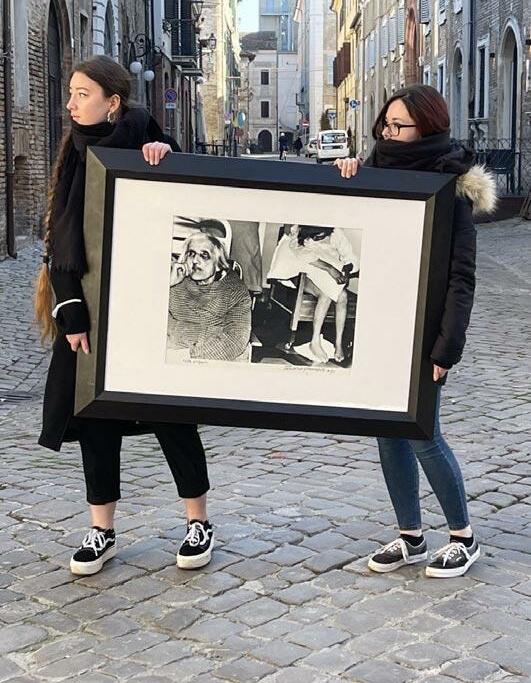
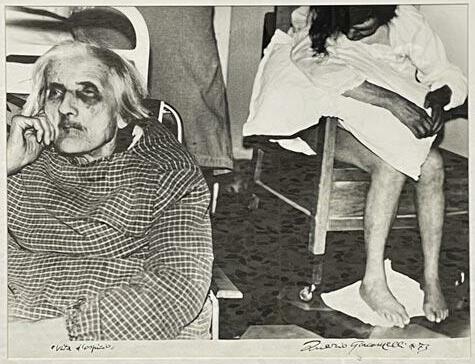
Lot 14
Extra large silver print, 650x500 mm, printed 1973, titled, signed dated, ink, on mount,“Via Mastai 24” stamp, verso original frame on artist’s instructions, blackened wood, 106x86 cm 6.000/8.000 Strong contrast, probably printed by Dorando Ubaldi, Ostra. Arturo Carlo Quintavalle, Mario Giacomelli, Feltrinelli, 1980, page 94. Emanuele Bugatti, Mario Giacomelli, civica raccolta, Senigallia, 2001, page 122
Mario Giacomelli
Io non ho mani che mi accarezzino il viso, 1973 (1963)
Silver print, 310x406 mm, printed 1973, signed, ink, on image recto, signed and titled, pencil, on otiginal mount, signed, ink, and repeated “Via Fratelli Bandiera 25” address stamp, verso
5.000/6.000
Alistair Crawford, Mario Giacomelli, Phaidon, 2001, page 226-227 (double-page).
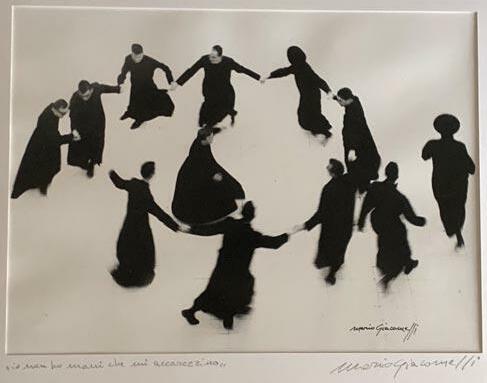
Lot 15
"On October 19, 1957, Mario Giacomelli left for Scanno, a small town in Abruzzo, together with his friend, photographer Renzo Tortelli.
On several occasions, talking about the motivations that had pushed him to go, Giacomelli expressed himself by saying that he had been struck by a man's story about this village where animals circulated freely, cars could not turn because of the many steps and where people dressed all in black.
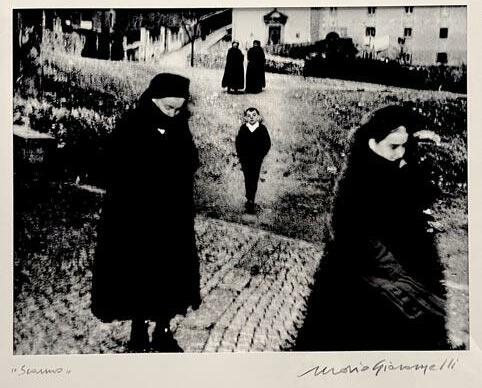
In reality, it seems impossible that he didn't already know the notoriety of Scanno, since for some time this village had been a popular destination for photographers. Also in the wake of the great ethnological investigations undertaken by many researchers and photographers, the south of Italy kept in the collective imagination that hint of exoticism absent in the rest of the Belpaese; moreover, Scanno being one of the most suggestive places of the south of Italy, in 1951, the photographer Henri Cartier-Bresson had realized a reportage of extraordinary beauty.
Mario's journey began by train, late in the evening. From Senigallia, his hometown, he arrived in Civitanova Marche, where his friend Tortelli was waiting for him and with whom, in a small Cinquecento, he undertook the journey at night to arrive at dawn on Saturday the 19th [...].
At the beginning Mario told me that his trip in 1957 was the only one in which he took pictures of Scanno with great passion and transposrto. He said that afterwards he returned to that 'fairytale village' only once, in the first days of May 1959, but that however, on this second occasion, he almost didn't take any pictures, because for him the place had lost that initial magic. Actually from many documents we know that he returned to Scanno many other times afterwards, especially after his most famous photograph became known in the world.
At the beginning the date of the shot was always declared by Mario as 1957, while later on, in catalogs, exhibitions and in some interviews he started to declare two dates for the work done in Scanno: 1957 and 1959. He always maintained his position that the second time he almost didn't shoot for the reasons mentioned above. Which photographs, then, were taken in 1957 and which in 1959? More importantly, in which year of the two was the photograph of the child actually taken? is remains a mystery."
Mario Giacomelli
Il Bambino di Scanno, 1973 (1959)
Silver print, 300x400 mm, printed 1973, signed and titled on original mount, original frame chosen by the artist 6.000/8.000
Arturo Carlo Quintavalle, Mario Giacomelli, Feltrinelli, 1980, cover and page 132. Emanuele Bugatti, Mario Giacomelli, civica raccolta, Senigallia, 2001, page 110. Virginia Heckert, Mario Giacomelli, Figure, Groud, Getty, 2021, plate 29, page 49
Lot 16
Simona Guerra published a remarquable essay on the young Scanno Boy : Il bambino di Scanno, Edizioni Postcart, 2016
Mario Giacomelli

La vedova di Scanno, 1973 (1957)
Vintage silver print, 300x395 mm, printed 1973, signed (decoloration of the ink), lower right angle, recto, signed, stamp, verso, small tear, ca. 7 mm, on left margin 4.000/5.000
Arturo Carlo Quintavalle, Mario Giacomelli, Feltrinelli, 1980, page 129. Enzo Carli, Il reale immaginario di Mario Giacomelli, il lavoro editoriale, 1988, page 62. Virginia Heckert, Mario Giacomelli, Figure, Groud, Getty, 2021, plate 27, page 47 (Lone Scanno Townswoman)
Lot 17
Mario Giacomelli
Paesaggio, 1973

Extra large silver print, 620x440 mm, printed 1973, signed and dated, ink, on mount, original frame on artist’s instructions, blackened wood, 106x86 cm, “Corniceria Angelini” label
5.000/6.000
Strong contrast, probably printed by Dorando Ubaldi, Ostra. Alistair Crawford, Mario Giacomelli, Phaidon, 2001, page 313 (variant cropping)
Lot 18
Mario Giacomelli
Le mie Marche, 1978
Vintage silver print, 300x400 mm, signed and titled, pencil, on original mount, Angelini’s frame 2.000/3.000
Arturo Carlo Quintavalle, Mario Giacomelli, Feltrinelli, 1980, page 278. Jesi Rotary Club, exhibition catalogue, 1994, page 127. Alistair Crawford, Mario Giacomelli, Phaidon, 2001, page 338
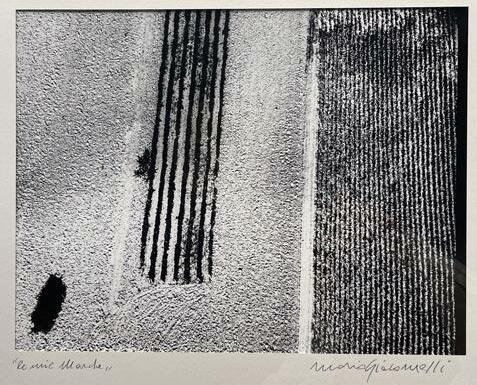
Lot 19
Mario Giacomelli
La Mietitura nelle mie Marche, 1978
Vintage silver print, 300x400 mm, signed and titled, pencil, on original mount, Angelini’s frame 2.000/3.000


Arturo Carlo Quintavalle, Mario Giacomelli, Feltrinelli, 1980, page 274 (di erent cropping). Alistair Crawford, Mario Giacomelli, Phaidon, 2001, page 346-347 (same cropping, douple page).
Carlo Emanuele Bugatti, Mario Giacomelli, civica raccolta, Senigallia, 2001, page 30
Lot 20
ADDENDA
Mario Giacomelli
Presa di coscienza sulla natura — "Da me creata" , 1978 -1963 ?
Silver print, 270x397 mm, red title stamp, address stamp "via Mastai 24”, proud annotation : “da me creata”, ink, verso 1.500/2.000
Emanuele Bugatti, Mario Giacomelli, civica raccolta, Senigallia, 2001, page 227 (di erent closer cropping)
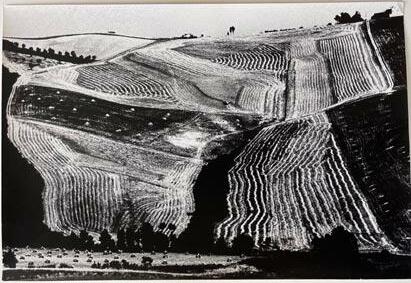
Lot 20-A
+ 8 lots numbered 20-A/20-H
Mario Giacomelli
Presa di coscienza sulla natura — "Da me creata" , 1978 -1963 ?
Silver print, 290x395 mm, red title stamp, two address stamps "via Mastai 24”, annotation : “da me creata”, ink, verso
1.500/2.000
Mario Giacomelli
Presa di coscienza sulla natura — "Da me creata" , 1978 -1955 ?
Silver print, 275x391 mm, red title stamp, address stamp "via Mastai 24”, annotation : “da me creata”, ink, verso
1.500/2.000
Alistair Crawford, Mario Giacomelli, Phaidon, 2001, page 369
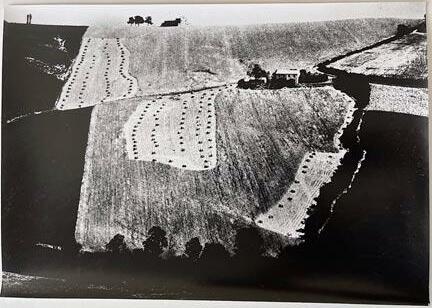

Lot 20-C Lot 20-B
Mario Giacomelli
Presa di coscienza sulla natura — "Da me creata" , 1978 -1955 ?
Silver print, 293x395 mm, red title stamp, address stamp "via Mastai 24”, annotation : “da me creata”, ink, verso
1.500/2.000
Alistair Crawford, Mario Giacomelli, Phaidon, 2001, page 376 (same negative, di rent, closer cropping)
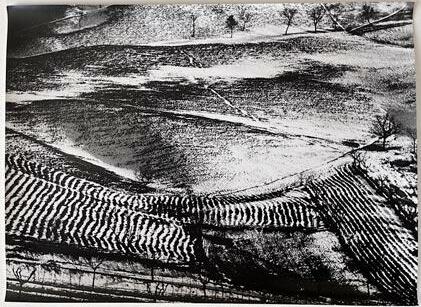
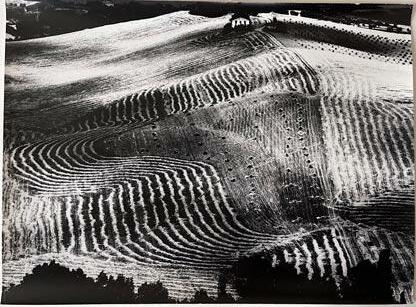
Mario Giacomelli
"Paesaggio Rita" , verso Fossombrone, 1975
Silver print, 292x397 mm, red large address stamp "via Mastai 24”, annotation : “Paesaggio Rita”, ink, verso
2.000/2.500
Alistair Crawford, Mario Giacomelli, Phaidon, 2001, page 334 (same negative, di rent, closer cropping)
Lot 20-E Lot 20-D
Mario Giacomelli
"Paesaggio Mario" , 1975 -July 1969
Silver print, 295x398 mm, red large address stamp "via Mastai 24”, annotation : “Paesaggio Mario”, ink, verso
2.000/2.500
Jesi Rotary Club, Exhibition catalogue, 1994, page 134. Enzo Carli, Mario Giacomelli, La forma dentro Charta, 1995, page 72, “...resa estetica caratteristica della scrittura con la luce di Mario Giacomelli; sgranata e a forte contrasto e soprattutto la terra che sale che è una impronta del lessico di Cavalli rielaborata da Mario. Quindi una versione particolare e personale, quindi di Mario.”. Alistair Crawford, Mario Giacomelli, Phaidon, 2001, page 323. Emanuele Bugatti, Mario Giacomelli, civica raccolta Senigallia, 2001, page 56
Mario Giacomelli Paesaggio , 1978


Silver print, 290x392 mm, red large address stamp "via Mastai 24”, cancelled printing annotations and date : “1978”, ink, verso
1.500/2.000
Emanuele Bugatti, Mario Giacomelli, civica raccolta Senigallia, 2001, page 71
Lot 20-G Lot 20-F
Mario Giacomelli

Paesaggio , 1978
Silver print, 290x392 mm, red address stamp "via Mastai 24”, date : “1978”, ink, verso 1.500/2.000
Lot 20-H
Mario Giacomelli
Occhi semichiusi (Self-portrait), 1978

Vintage silver print, 135x85 mm, photographer’s stamp, verso 400/500
Virginia Heckert, Mario Giacomelli, Figure, Groud, Getty, 2021, page 157, same negative, softer tones
Lot 21
Sandro Luchetti, detto il Postino, was following Mario Giacomelli’s instructions, indicated sometimes in ink, in other occasions in pencil — annotations at the versos of the provini (credit Pietro Picchietti)
Mario Giacomelli
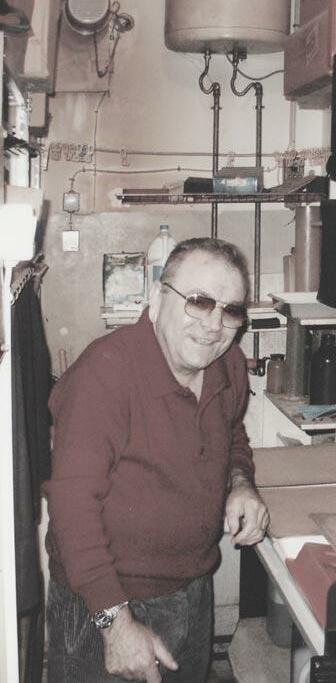
“A sinistra, inserisci un po’ di bianco ...” (Scanno), c. 1980 (1957)
Test silver print, 210x275 mm, ca. 1980, with artist’s instructions for printer Sandro Luchetti, ink, recto

Lot 22
400/500
Mario Giacomelli
Ostra, Strada di Alaric, provino “325”, ca. 1980
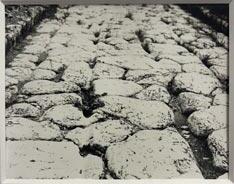
Test silver print on Agfa paper, 85x113 mm, watermark, indications by the artist for printer, pencil, verso 300/400
Ostra Vetere was a Roman city located along the first via Flaminia on the left bank of river Misa, close to Senigallia. e city was abandoned following the barbarian invasions, after the city was destroyed in 410 by the Visigoths of Alaric.

Lot 23
Mario Giacomelli
Provino “433”, ca. 1980
Test silver print, 75x118 mm, printing indication by the artist, pencil, verso 200/300
Mario Giacomelli

Provino “48”, ca. 1980
Test silver print, 80x80 mm, printing indication by the artist, pencil, verso 200/300

Lot 25 Lot 24
Mario Giacomelli
Provino “812”, ca. 1980
Test silver print, 80x105 mm, printing indication by the artist, pencil, verso 200/300
Mario Giacomelli
Provino “136”, ca. 1980
Test silver print, 70x105 mm, printing indication by the artist, pencil, verso 200/300


Lot 27 Lot 26
Mario Giacomelli
Provino “484”, ca. 1980
Test silver print, 78x102 mm, printing indication by the artist, pencil, verso 200/300

Mario Giacomelli
Provino “104”, ca. 1980
Test silver print, 80x100 mm, printing indication by the artist, pencil, verso 200/300
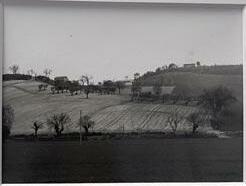
Lot 29 Lot 28
Mario Giacomelli
Provino “672”, ca. 1980
Test silver print, 80x100 mm, printing indication by the artist, pencil, verso 200/300
Mario Giacomelli
Provino “266”, ca. 1980
Test silver print, 80x105 mm, printing indication by the artist, pencil, verso 200/300


Lot 31 Lot 30
Mario Giacomelli
Provino “429”, ca. 1980
Test silver print, 78x110 mm, printing indication by the artist, pencil, verso 200/300

Mario Giacomelli

Provino “29”, ca. 1980
Test silver print, 80x105 mm, printing indication by the artist, pencil, verso 200/300
Lot 33 Lot 32
Mario Giacomelli
Provini “591” e “668”, ca. 1980
Two test silver prints, 85x95, 87x95 mm, printing indication by the artist, pencil, verso (2) 300/400
Alistair Crawford, Mario Giacomelli, Phaidon, 2001, page 202


Mario Giacomelli

Provino senza numero, ca. 1975
Test silver print, 180x130 mm, small crease in the lower right corner 300/400
Lot 35 Lot 34
Mario Giacomelli

Caroline Branson, ca. 1972
Vintage silver print, 295x400 mm, “Via Mastai 24” adress-stamp and “Caroline Branson” title-stamp, verso 1.500/2.000
Alistair Crawford, Mario Giacomelli, Phaidon, 2001, pages 252-253 (variant). Emanuele Bugatti, Mario Giacomelli, civica raccolta, Senigallia, 2001, page 107
Lot 36
Mario Giacomelli
Scanno, 1978 (1957)
Silver print, 400x295 mm, printed circa 1978, dated, ink, by the artist “1957” two stamps, verso
3.000/4.000
Alistair Crawford, Mario Giacomelli, Phaidon, 2001, page 290. Emanuele Bugatti, Mario Giacomelli, civica raccolta, Senigallia, 2001, page 83
Mario Giacomelli
Scanno, 1978 (1957)

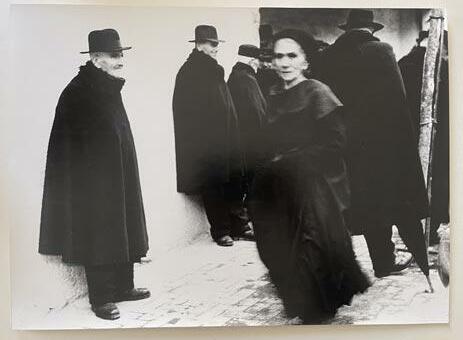
Silver print, 295x400 mm, printed circa 1978, dated, ink, by the artist “1957/59”, two stamps, verso
3.000/4.000
Alistair Crawford, Mario Giacomelli, Phaidon, 2001, page 293. Emanuele Bugatti, Mario Giacomelli, civica raccolta Senigallia, 2001, page 116
Lot 37 Lot 38
Scanno, 1978 (1957)

Silver print, 400x295 mm, printed circa 1978, dated twice, ink, by the artist “1957”, four stamps, verso
3.000/4.000
Lot 39
Mario Giacomelli
Mario
Giacomelli

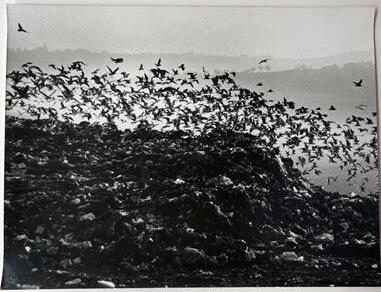
Senza titolo (Giardino), Senigallia, ca. 1983
Vintage silver print, 302x405 mm, “Via Mastai, 24” black stamp
1.000/1.200
Mario Giacomelli
Gabbiani riciclano, Senigallia, ca. 1983
Vintage silver print, 300x400 mm, “Via Mastai, 24” black stamp
1.000/1.200
Lot 41
Lot 40
MARIO GIACOMELLI
COLORI
Natura Morta rossa-verde, ca. 1978 Vintage Kodachrome print, 156x232 mm, paper watermark “Kodak” 600/800

Lot 42
Mario Giacomelli
Mario Giacomelli
Dietro il muro di casa, ca. 1978 (1958)
Chromogenic print, 399x297 mm, printed circa 1978 from a 1958 negative, signed, verso, ink, signed, titled, on artist’s original mount, date “1988”, pencil, tiny marginal decoloration
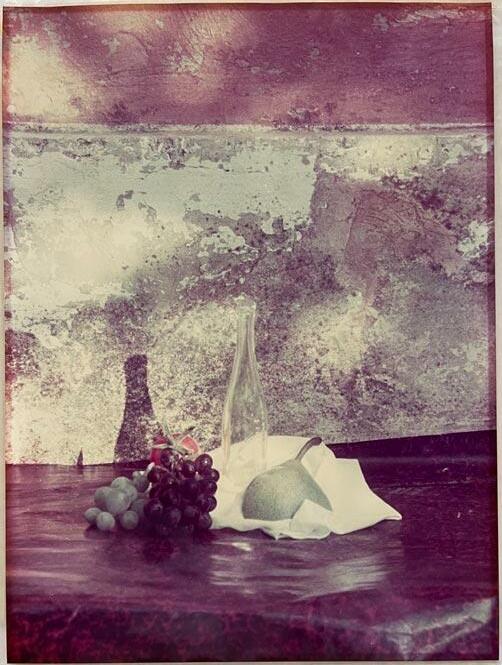
3.000/4.000
Arturo Carlo Quintavalle, Mario Giacomelli, Feltrinelli, 1980, page 31. Carlo Emanuele Bugatti, Mario Giacomelli, civica raccolta Senigallia, 2001, page 97. Virginia Heckert, Mario Giacomelli, Figure, Groud, Getty, 2021, plate 5, page 19, with title “Natura viva nella poesia”.
Lot 43
Mario Giacomelli
Spazio poetico, 1980
Experimental color print, 200x262 mm, authenticated “Copia originale scattata sviluppata ...”, pencil, verso
500/600
Virginia Heckert, Mario Giacomelli, Figure, Groud, Getty, 2021, page 156


Mario Giacomelli
Barca nel porto di Senigallia, 1980
Experimental color print, 200x262 mm, authenticated “Copia originale scattata sviluppata ...”, pencil, verso 500/600
Lot 45 Lot 44
Fantasia, 1987
White ink and paint on silver print, 200x255 mm, printed and painted 1987, stamp, verso 800/1.000
Unpublished work
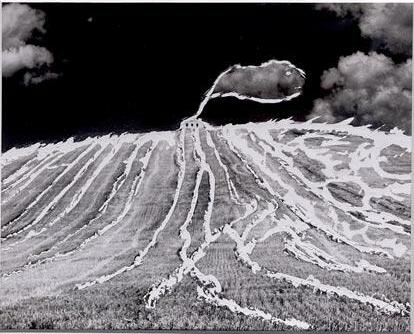 Mario Giacomelli
Mario Giacomelli
Lot 46
DIPINTI, QUADRI a seguire: supplemento L’ARTISTA NELLA CITTÀ il tipografo, lo stampatore
ASTA DI SENIGALLIA
On 14 March 2022, just weeks ago, opened an exhibition in the spaces of the Museo Laboratorio di Arte Contemporanea della Sapienza entitled Tra pittura e fotografia (Between Painting and Photography) . e exhibition - curated by Irene Caravita in collaboration with the Archivio Mario Giacomelli - presents works that have never been seen before, or at least have never been seen for half a century. Although Giacomelli painted (and wrote verses) from a very young age and throughout his life, only some of his works had in fact been exhibited during the 60s and 70s.
We present here four paintings by Mario Giacomelli which were decorating since 50 years the wall of one of Senigallia’s most famous hotels, lots 47-50, and a few canvases by other local artists and friends, from the same provenance, lots 51-57.
Mario Giacomelli
Abstraction, 1967
Gouache on Canvas, 50x40 cm, signed, dated “*67” lower right angle, original gilded wood frame 3.000/4.000

Lot 47
Mario Giacomelli
Abstraction with relief, 1969

Mixed media and oil on canvas, 49,5x70 cm, signed and dated “*69”, lower right angle, original gilded wood frame choosen by the artist
3.000/4.000
Lot 48
Mario Giacomelli
Il portone del povero, 1970

Gouache and mixed technique on cloth mounted on masonite, 80x60 cm, signed and dated, lower left angle, gilded frame, 107x88 cm, artist’s manuscript label at “Via Mastai 24” address and Cornici Angelini reference 5.000/6.000

Lot 49
Attr. to Mario Giacomelli
Senza titolo con rilievo, ca. 1971

Mixed technique, oil on canvas, 34x43 cm, vintage wooden frame, framing technical annotation: “[Modelo cassetta] bianco, slip chiaro”, pencil, on canvas verso, original wood frame from an unidentified studio
2.000/3.000
Attribuition is confirmed by the 90 years old early owner, close friend of Mario Giacomelli
Lot 50
Enzo Marinelli (1924-2001)
Marina, Senigallia, 1978
Oil on canvas, 35x50 cm, signed, authentication stamp, dated and signed, canvas verso, framed 600/800
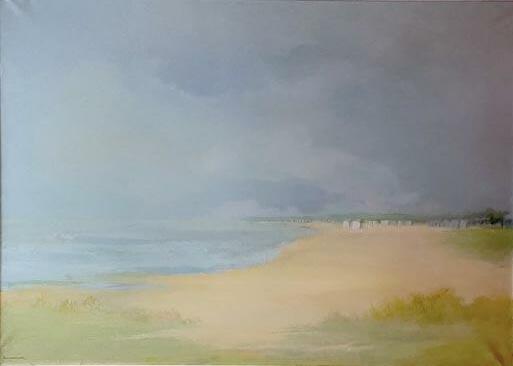

Enzo Marinelli Spiaggia di Senigallia, 1982
Large oil on canvas, 100x140 cm, signed, authentication stamp, dated and signed, canvas verso, framed
1.800/2.000
Lot 52 Lot 51
Enzo Marinelli
Foro Annonario, Senigallia, June 1990
Oil on canvas, 60x50 cm, signed, authentication stamp, dated and signed, canvas verso, framed 900/1.000

Enzo Marinelli
La Vela, Porto di Senigallia, ca . 1990

Oil on canvas, 99x70 cm, signed, authentication stamp, signed, canvas verso, framed, Corniceria Angelini stamp
1.500/2.000
Lot 54 Lot 53
Dante Panni (1924-1996)
Dove c’era la Fiera di Sinigaglia, 1972
Pastel, chalk on paper (gesso su carta), 48x68 cm, signed, in the original wooden frame 500/600

Dante Panni
Senigallia dietro il ponte della ferrovia, ca. 1972
Pastel, chalk on paper (gesso su carta), 50x70 cm, signed, left angle, initialed, verso, in the original wooden frame 600/800

Lot 56 Lot 55
Ivo Pompili
I Capanni, spiaggia di Senigallia, 1977

Oil on canvas, 50x70 cm, signed, dated, recto, label, signed, verso, in the original wooden frame
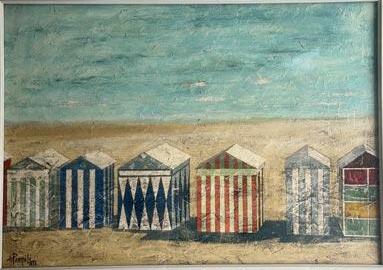
500/600
Enzo Carli Acquatica , 1994
Large vintage silver print, 700x1000 mm, signed, titled, signed, verso, stamped, verso, framed 2.500/3.000
Premiered at the KN Gallery of Ancona 1995, as e Manifesto of the Photographers of the Centro Studi Marche Passaggio di Frontiera
Lot 58
Lot 57
Senigallia, Guida Turistica, [October 1972]
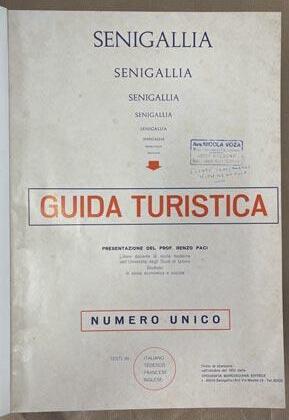
Small folio, 335x240 mm, printed cover, 1 leaf and 366 pages, mute blue cloth, numerous reproductions 150/200
We find a seven-pages section dedicated to Giacomelli as a local artist, texts by Giuseppe Turroni, Piero Racanicchi, Erwin Melchart, Serge Maubec, on pages 211-217, ex-libris Nicola V., who spent the Summer of 1980 at the Hotel de la Ville

Lot 59
Mario Giacomelli (illustrator and printer)
Ubicazione: Etiopia. In 1974, Giacomelli accompanied by the spirit a missionary native of Senigallia, loaded with a prepared photographic camera. Giacomelli wanted to participate, to testify of the horror of this famine. Quintavalle devoted an entire chapter to those prints, n°XXII in the 1980 catalogue.

Italian missionary (printed by Mario Giacomelli)
Perché, Wollamo, Etiopia, 1974
Vintage silver print, 280x393 mm, stamped 1.000/1.200
Arturo Carlo Quintavalle, Mario Giacomelli, Feltrinelli, 1980, page 245
Italian missionary (printed by Mario Giacomelli)
Perché, Wollamo, Etiopia, 1974
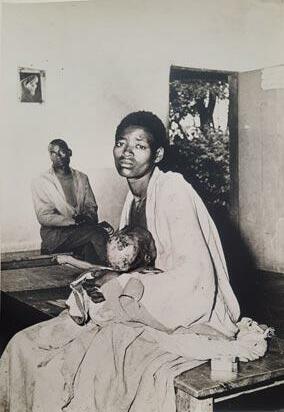
Vintage silver print, 377x273 mm, stamped 1.000/1.200
Arturo Carlo Quintavalle, Mario Giacomelli, Feltrinelli, 1980, page 250
Lot 61
Lot 60
Italian missionary (printed by Mario Giacomelli)
Perché, Wollamo, Etiopia, 1974
Vintage silver print, 294x392 mm, stamped 1.000/1.200
Arturo Carlo Quintavalle, Mario Giacomelli, Feltrinelli, 1980, page 247
Italian missionary (printed by Mario Giacomelli)
Perché, Wollamo, Etiopia, 1974


Vintage silver print, 395x282 mm, stamped 1.000/1.200
Arturo Carlo Quintavalle, Mario Giacomelli, Feltrinelli, 1980, page 246
Lot 63 Lot 62
Ubicazione: Ladakh. In 1977, Giacomelli accompanied by the spirit a young hippie native of Senigallia, loaded with a prepared photographic camera. Giacomelli wanted him to participate to a rare meeting in the Himalaya, and bring back some rolls of this encounter. When Enea returned from his trip, Giacomelli was impressed by the reportage and organised the edition of the images.

Enea Discepoli (printed by Mario Giacomelli)
La terra delle ombre lunghe, Ladakh , 1977(1976)
Silver print, 267x390 mm, printed 1977, from a Discepoli’s 1976 negative, signed by Mario Giacomelli, recto, by Discepoli, stamp, verso 1.500/2.000

Enea Discepoli (printed by Mario Giacomelli)
La terra delle ombre lunghe, Ladakh , 1977(1976)
Silver print, 404x304 mm, printed 1977, from a Discepoli’s 1976 negative, signed by Discepoli, stamp, verso 1.200/1.500
Lot 65
Lot 64
Enea Discepoli (printed by Mario Giacomelli)
La terra delle ombre lunghe, Ladakh , 1977 (1976)
Silver print, 304x404 mm, printed 1977, from a Discepoli’s 1976 negative, signed by Discepoli, verso, stamp 1.000/1.200

Enea Discepoli (printed by Mario Giacomelli)
La terra delle ombre lunghe, Ladakh , 1977 (1976)
Silver print, 404x304 mm, printed 1977, from a Discepoli’s 1976 negative, signed by Discepoli, verso, stamp 1.500/2.000

Lot 66
Lot 67
Lot
A cura di Quintavalle [Mio, ho solo questo], Mario Giacomelli, 1980
In-4, 225x225 mm, 280 pages, signed on cover by Mario Giacomelli with the explicit mention : “Mio, Ho solo questo ; Mine, I have only this copy”, signature and mention repeated on end-pagest

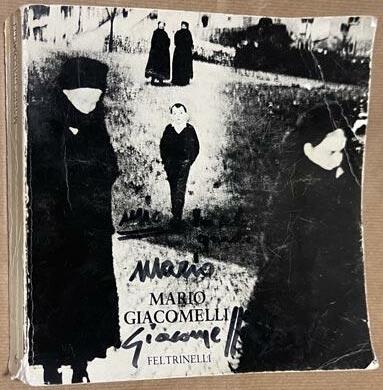
200/300
e Feltrinelli 1980 catalogue, a milestone in the artist destiny during his lifetime. e artist’s personal copy was preserved by collectors in Senigallia. Local associations are struggling to buid a Giacomelli research center with the support of local institutions.
Mario Giacomelli
Storie di Terra, Mostra di Jesi, 1980
Lot 69
Printed exhibition poster, 996x690 mm 20/30 68
Lot
Mario Giacomelli
fotografie, Mostra di Urbino, 1981
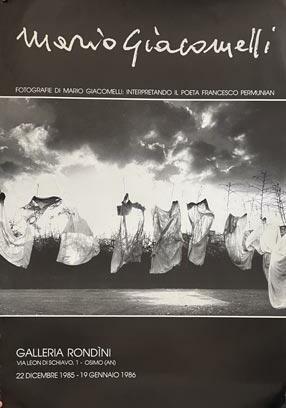

Printed exhibition poster, 995x700 mm 20/30
Mario Giacomelli
Mostra di Osimo, 1985
Printed exhibition poster, 995x677 mm 20/30
Lot 71
70
Concerto ... Re Niliu, Senigallia, 28 Luglio 1987

Printed exhibition poster, 983x685 mm , printed on heavy paper by Mario Giacomelli in his Tipografia 40/50
A cura di Enzo Carli Fotografia, Ancona, Adriatica editrice, 1990 In-4, 230x225 mm, 321, black cloth, illustrated dust-jacket 120/150
Milestone book on postwar Italian photography, inspired by Mario Giacomelli’s ideas.

Lot 72 Lot 73
Mario Giacomelli (photographer and typographer)
Pietro Picchietti
Mario Giacomelli, Montecarotto, 6 January 1993
Silver print, 300x240 mm, stamped, signed and captioned, pencil, verso 250/300
With his camera Kobell, 6x7, during the pasquella, a review of popular songs, organised by the Macina (Jesi folk song and research group).
Pietro Picchietti
Mario Giacomelli, Montecarotto, 6 January 1993
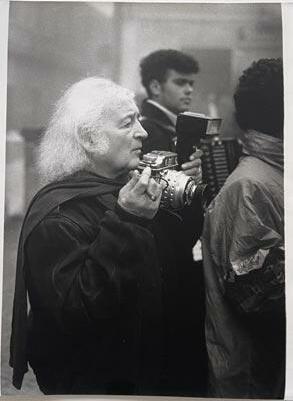
Silver print, 300x240 mm, stamped, signed and captioned, pencil, verso 250/300

Lot 75 Lot 74
Mario Giacomelli
Bird-eye View of La Rocca, 1995

Serigraphic black print, 300x400 mm, with gouache additions, first of an edition of only two hand-coloured prints, original frame, chosen by the artist
600/800
Mario Giacomelli
For Ristorante Saraghino, Numana, 1995 (1960)
Original silver print given by the artist to the owner for her restaurant, with a copy of the menu, printed in Giacomelli’s Tipografia Marchigiana printing house, Senigallia 800/1.000
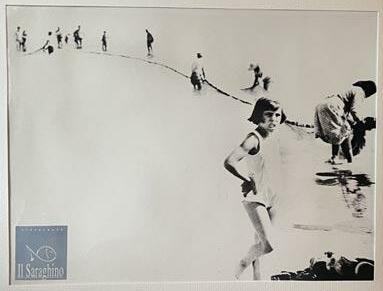
Provenance : Ristorante Sarraghino. Alistair Crawford, Mario Giacomelli, Phaidon, 2001, page 413 (douple page).

Lot 76
Lot 77
Mario Giacomelli
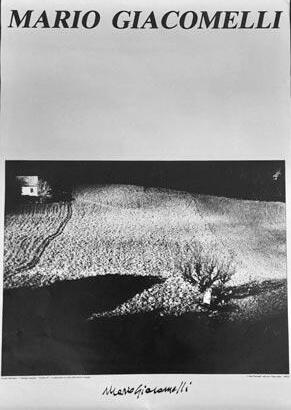
Misterbianco (Sicily), 1989
Printed exhibition poster, 700x500 mm 20/30
Mario Giacomelli (& Enzo Carli)

La forma dentro, fotografie 1952-1995, Senigallia, 1995
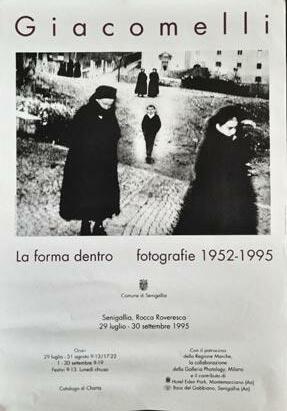
Printed exhibition poster, 992x690 mm, catalogue in-4, 246 pages 50/80
e main antological exhibition catalogue, approved by the artist, together with the poster, published by Charta
Lot 78 Lot 79
Mario Giacomelli (illustrator and typographer)

Petites Histoires de la photographie, 1999

Print poster for a Paris exhibition and catalogue announcement, with the reproduction of a Spoon River series photograph, printed in Giacomelli’s Tipografia Marchigiana, Senigallia 20/30
is poster was printed during the Summer of 1999, and the intended catalogue was postponed after the Zones Banlieues issue, September 1999, then euros banknotes were introduced on January, 1st, 2002, but the red label was a xed by anticipation.
A cura di Carlo Emanuale Bugatti Mario Giacomelli, civica raccolta, Senigallia, 2001
In-4, 272x225 mm, 280 pages, color cover 50/60
e Senigallia 2001 catalogue, whose distribution was stopped and forbidden by the artist’s family, probably merely destroyed now.
Lot 80 Lot 81
R.A. Cornelius (born 2004)
Mario Giacomelli, Senigallia, 2021
Oil on Canvas, 400x300 mm, signed, dated, verso 300/400

Qua finisce il catalogo
Collaborazioni e ringraziamenti
Per le dediscalie abbiamo dovuto ricorrere all’amicizia e alla dottrina di molte persone, delle quali ci corre obbligo di registrare qui i nomi, ringraziandole. Per la parte del catalogo che spetta agli anni 1970 avemmo schiarimenti da Enzo Carli, Brent Sikemma, Paola Casagrande, Pietro Picchietti, Giuseppe Perlini, Otello Balduini, Loris Manoni, Enea Discepoli. Ci soccorse gli articoli i Arturo Carlo Quintavalle, Carlo Emanuele Bugatti, gli incentivi di Jean-Claude Lemagny, Anne Biroleau, Michel Frizot, Michel Collet, Luisa e Sonia Natale, Oliviero Casacchia, Francesca Bonetti, Leonardo Badioli.
Ringraziamo il Comune di Senigallia, la corneceria Angelini, i fotografi del guppo Pasaggio di Frontiera e ancora Enzo Carli, l’albergo Terrazza Marconi, l’albergo Bice, il ristorante Spirito Libero, l’hôtel Parister (Paris), Michele Smargiassi, Simona Guerra, gli artisti e abitanti di Senigallia per comenti e consigli, é per aiuti tecnici e logistici Gabriele, Irma, Marcelo, Lorena, Fabrizio, Lorenzo, Raphael, Margaux, Céline, Marion, Emanuele.
Lot 82


SENIGALLIA CITTÁ DELLA FOTOGRAFIA MOSTRE, GALLERIE MAGGIO 2022 PAOLO MONINA 11 maggio -15 luglio 22 41 via Fratelli Bandiera Curata da Margaux Carrez, Céline Esposito Emanuele Morelli & Marion Pardo
SENIGALLIA
ATELIER




LA FOTOGRAFIA UNISCE LE ISTITUZIONI A SENIGALLIA ROGER BALLEN 14 APRILE 2022- 2 OTTOBRE 2022 PALAZZO DEL DUCA - PALAZZETTO BAVIERA - SENIGALLIA UNA GIORNATA NELLA VITA DI VASSILI KANDINSKY SGUARDI SUL PASSATO Senigallia 13-27 maggio 2022 Indagine a cura di Margaux Carrez Céline Esposito Marion Pardo Marina Benediktova Emanuele Morelli



ATELIER 26 gestito da Patrizia Lo Conte Alfonso Napoletano da 64 64 22 aprile - 30 maggio Bandiera 64
Durante la settimana del 14 maggio l’elegante albergo Terrazza Marconi vi propone una formula speziale con la simplice parola chiave :

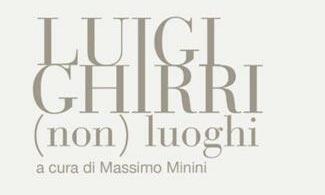


“asta di fotografia”

booking@terrazzamarconi.it Photo Gio Ghiandoni
“ Pazienza, un giorno capirai ” Mario Giacomelli

Finito di stampare il martedi 19 aprile dell’anno MMXXII terzo giorno dell’ottava di Pasqua, quando si narra l'apparizione di Gesù alla Maddalena sui torchi di Pixartprinting S.p.a. Quarto d'Altino, VE
Supplemento gratuito al N° 1 dalla rivista Atelier41 Direttore della pubblicazione : Serge Plantureux Via Fratelli Bandiera 41, 60019 Senigallia (AN) ISSN in preparazione fotografia@atelier41.press








































































 Mario Giacomelli
Mario Giacomelli




















































